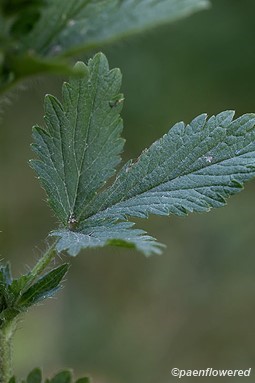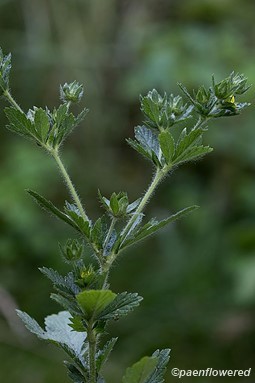Potentilla norvegica
Potentilla norvegica strawberryweed
Strawberryweed is a stout, hirsute, leafy herb that can be annual, biennial, or a short-lived perennial, unlike many Potentilla species, which tend to be longer-lived perennials. Also known as Norwegeian cinquefoil or rough cinquefoil, this plant begins as a rosette of basal leaves and grows into flowering stalks that are 1 to 3 feet high. During this early development stage, this plant can resemble Fragaria virginica (wild strawberry). The stems are covered in dense hairs and can be either erect or sprawling, with branches rising at the tips. The stems can also be green or tinged with red. The plant has compound stem leaves, divided into 3 leaflets that are elliptic to widely lance-shaped and coarsely serrated along the edges and hairy.
From June to August, small flowers arranged in compact clusters bloom with 5 yellow oval-heart shaped petals with each flower about ⅓ to ½ inches across and distinctive 5 green sharply-pointed sepals that are longer than the petals. However, flowers may not bloom all at once, giving an extended bloom period of a month or more. The pollen and nectar attract small bees and flies and small mammals will eat the foliage, becoming crucial for seed dispersion. This plant thrives in habitats that contain dry to slightly moist soils in full sun to partial shade and can typically be found in disturbed and weedy habitats such as wetlands, fields, meadows, roadsides, vacant lots, and waste areas. This plant is widely distributed across North America, and is classifed as secure (S5) in PA.
Some distinguishing features of P. norvegica from several other Potentilla species is its generally smaller yellow flowers, as well as its long, spreading hairy stems and sepals that are longer than the petals. In addition, unlike P. simplex (common cinquefoil) and P. canadesis (dwarf cinquefoil) with 5 leaflets, P. norvegica has three widely lance-shaped leaflets with coarse serrations. P. norvegica is also noticebly taller than most Pennsylvania's cinquefoils.
Habitat & Range
Grows in dry soils of waste grounds, roadsides, and thickets.
Common throughout the state.
| EMP: | FACU |
|---|---|
| NCNE: | FAC |
Phenology
Flowers from June to August.
Characteristics
Inflorescence branched, terminal cluster (cyme); solitary flowers also occur from the upper leaf stalks
Flowers 5 yellow oval-heart shaped petals; green, sharp-pointed sepals longer than petals; 15 or more stames with yellow anthers and yellow filaments; ⅓ to ½″ across
Leaves compound, divided into 3 leaflets, becoming smaller and with shorter stalks moving up the stem, upper leaves may have no stalks
Cauline leaves compound, trifoliate, alternate; leaflets elliptic to obovate, serrate; 3″ long, abt 1½″ wide;
Basal leaves similar in shape to cauline, form a rossette; long stalks up to 4″
Stems upright, branching; densely covered with long hairs; green, can be tinged with red
Fruit cluster of 1 to 5 dry, flattened aggregated achenes on a convex, dry receptacle surrounded by persistent calyx
Height 1 to 3 feet
Plant Codes
S-rank: S5 (Secure)
G-rank: G5 (Secure)
Ecology
Main pollinators are small bees and flies. Foliage and seeds are occasionally eaten by mammals like rabbits, groundhogs, deer, and livestock.









Comments
Have you spotted this plant in your area? We'd love to hear about your experience! Share your comments or questions about the plant below. Comments are moderated before posting.